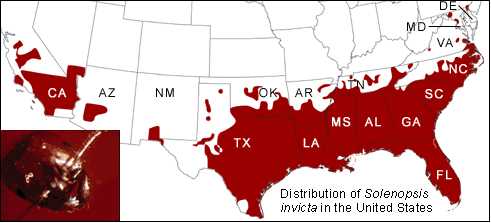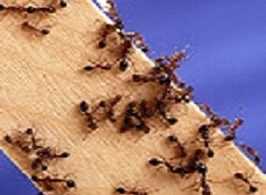INSECTS AND SCORPIONS
Fire Ants
Imported fire ants first came to the United States around 1930. Now there are five times more ants per acre in the United States than in their native South America. The fire ants that came to the United States escaped their natural enemies and thrived in the southern landscape.
Fire ants bite and sting. They are aggressive when stinging and inject venom, which causes a burning sensation. Red bumps form at the sting, and within a day or two they become white fluid-filled pustules.
U.S. Geographic Region

Graphic courtesy of
http://evolution.berkeley.edu/evolibrary/article/_0_0/fireants_02
Mostly the Southeastern United States, with limited geographic distribution in New Mexico, Arizona, and California.
Employer Recommendations
Employers should protect their workers from fire ants by training them about:
- Their risk of exposure
- How to identify fire ants and their nests
- How to prevent exposure
- What to do if they are bitten or stung
Worker Recommendations
Workers should take the following steps to prevent fire ant stings and bites:
- Do not disturb or stand on or near ant mounds.
- Be careful when lifting items (including animal carcasses) off the ground, as they may be covered in ants.
- Fire ants may also be found on trees or in water, so always look over the area before starting to work.
First Aid
Workers with a history of severe allergic reactions to insect bites or stings should consider carrying an epinephrine auto injector (EpiPen) and should wear a medical identification bracelet or necklace stating their allergy.
Workers should take the following steps if they are stung or bitten by fire ants:
- Rub off ants briskly, as they will attach to the skin with their jaws.
- Antihistamines may help.
- Follow directions on packaging.
- Drowsiness may occur.
- Take the worker to an emergency medical facility immediately if a sting causes severe chest pain, nausea, severe sweating, loss of breath, serious swelling, or slurred speech.
- Page last reviewed: July 1, 2016
- Page last updated: July 1, 2016
- Content source:
- National Institute for Occupational Safety and Health Education and Information Division


 ShareCompartir
ShareCompartir
